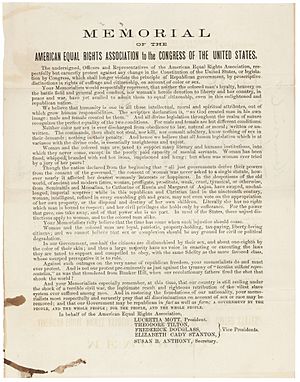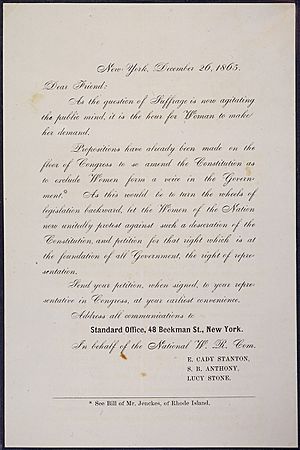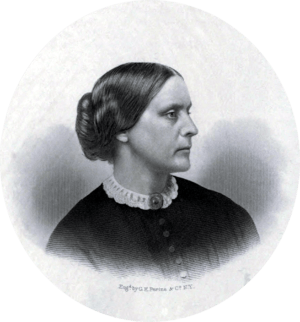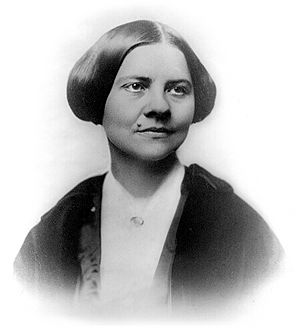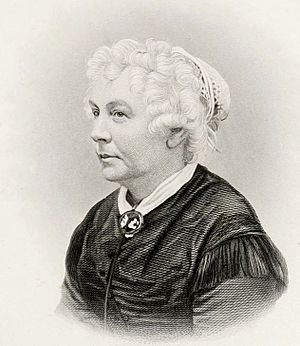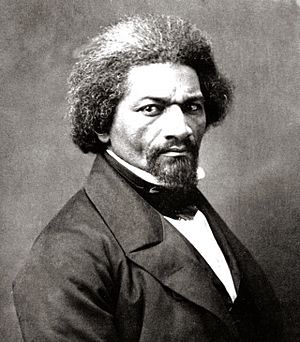American Equal Rights Association facts for kids
| Abbreviation | AERA |
|---|---|
| Formation | 1866 |
| Dissolved | 1870 |
|
Key people
|
Lucretia Mott, Frederick Douglass, Susan B. Anthony, and Elizabeth Cady Stanton |
The American Equal Rights Association (AERA) was a group formed in the United States in 1866. Its main goal was to get "Equal Rights to all American citizens." This especially meant the right to vote, no matter their race, skin color, or gender.
Many important activists of that time joined the AERA. This included women and men, and both black and white people.
The AERA was created from the Eleventh National Women's Rights Convention. This meeting decided to become a new organization. Leaders of the women's movement had wanted to join with the American Anti-Slavery Society. But that group did not agree to their idea.
Contents
History of the AERA
Starting the AERA in 1866
The AERA was officially started on May 10, 1866, in New York City. This happened at the Eleventh National Women's Rights Convention. It was the first such meeting since the American Civil War ended.
Frances Ellen Watkins Harper, an African American writer and activist, spoke at the meeting. She shared her experience as both a woman and a black person. She said, "You white women speak here of rights. I speak of wrongs."
The convention decided to change into the American Equal Rights Association (AERA). This new group would work for the rights of both women and black people. They wanted voting rights for everyone. Lucretia Mott was chosen as president. Elizabeth Cady Stanton, Susan B. Anthony, and Lucy Stone were on the executive committee.
The AERA started campaigns in different states. They hoped to gain enough support for universal suffrage. This meant voting rights for everyone, not just black men.
Key People in the AERA
Many important activists were part of the AERA. They had often worked together before in the anti-slavery and women's rights movements.
- Lucretia Mott was the president of the AERA. She was an abolitionist who fought against slavery. She also helped organize the 1848 Seneca Falls Convention. This was the first women's rights meeting.
- Elizabeth Cady Stanton helped organize the Seneca Falls Convention. She wrote the Declaration of Sentiments, which called for women's rights.
- Lucy Stone was a pioneer for women's rights. She helped organize the first National Women's Rights Convention in 1850.
- Susan B. Anthony was a strong voice for women's rights. She also worked against slavery.
- Frederick Douglass was an escaped slave and a leader in the fight against slavery. He also supported women's rights.
- Frances Ellen Watkins Harper was a Black American poet and anti-slavery speaker.
- Abby Kelley Foster and her husband Stephen Symonds Foster were abolitionists. They encouraged Susan B. Anthony to join the anti-slavery movement.
- Henry Brown Blackwell worked against slavery and for women's rights. He was married to Lucy Stone.
- Sojourner Truth was a former slave. She was a powerful speaker for both abolition and women's rights.
- Sarah Parker Remond was an abolitionist and activist for formerly enslaved Black people.
Events Leading to AERA's Creation
Before the American Civil War, the women's rights movement was growing. Many women became activists by working to end slavery. The American Anti-Slavery Society especially supported women's rights.
During the Civil War (1861–1865), the women's movement focused on ending slavery. In 1863, Elizabeth Cady Stanton and Susan B. Anthony formed the Women's Loyal National League. This group worked to pass an amendment to the U.S. Constitution to abolish slavery.
After slavery was abolished by the Thirteenth Amendment in 1865, Wendell Phillips led the Anti-Slavery Society. He wanted to focus on getting political rights for black men. He told women's rights activists to wait for their voting rights.
Then, proposals for a Fourteenth Amendment came up. This amendment would grant citizenship to African Americans. But some versions would also add the word "male" to the Constitution for the first time. Stanton worried this would make it much harder for women to get the vote.
Stanton, Anthony, and Lucy Stone asked people to sign petitions against any wording that excluded women. A version of the amendment that said "persons" passed in the House of Representatives. But it failed in the Senate. The final version that passed Congress included the word "male" three times.
Stanton and Anthony opposed this amendment. But Stone supported it as a step toward universal suffrage. Frederick Douglass also spoke against it. The Fourteenth Amendment was approved in 1868.
In January 1866, Stone and Anthony suggested joining the Anti-Slavery Society with the women's rights movement. They wanted a new group to fight for rights for both African Americans and women. But Wendell Phillips blocked this idea. He said voting rights for black men were the most important issue.
Phillips and other abolitionist leaders believed that voting rights for former slaves would help the North's victory in the Civil War. They thought fighting for women's suffrage at the same time would make it harder to get voting rights for black men.
AERA's First Annual Meeting in 1867
The AERA held its first yearly meeting in New York City on May 9, 1867.
Lucretia Mott, the AERA's president, spoke about the growing demand for black men's voting rights. She said women had a right to be "a little jealous." She worried that black men, once they could vote, might not support women's voting rights.
Elizabeth Cady Stanton was asked if she would let black men vote before women. She said no. She feared that black men, after being oppressed, might become unfair rulers themselves. She wanted women and black men to get voting rights together.
Sojourner Truth, a former slave, agreed. She said if black men got rights but black women did not, black men would become "masters over the women." This would be "just as bad as it was before."
Others disagreed. Abby Kelley Foster thought voting rights for black men were more urgent. Stephen Symonds Foster said that voting rights for one group should not depend on another. He believed everyone's rights should be given as soon as possible.
Henry Ward Beecher, a famous minister, supported universal suffrage. But he thought asking for votes for both blacks and women might mean they would only win votes for black men.
Campaigns in New York and Kansas
New York Campaign
New York State was changing its constitution in June 1867. AERA workers held meetings and collected over 20,000 signatures. These petitions supported women's voting rights. They also wanted to remove rules that stopped black voters from owning property.
The committee for voting rights was led by Horace Greeley. He was a newspaper editor and abolitionist who had supported women's rights. His committee agreed to remove the property rules for black voters. But they rejected women's voting rights.
Greeley had argued with Anthony and Stanton. He wanted them to focus only on black men's rights in New York. When they refused, he threatened to stop supporting their work in his newspaper. He then began to attack the women's movement.
Stanton and Anthony showed that Greeley's own wife had signed their petition for women's suffrage. This campaign caused them to lose Greeley's friendship and the support of his newspaper, the New York Tribune.
Kansas Campaign
In 1867, voters in Kansas had two questions on the ballot. One was to give voting rights to black men. The other was to give voting rights to women. Kansas had a history of opposing slavery and good laws protecting women's rights.
The AERA put a lot of effort into this campaign. They hoped to win both votes. This would help the cause of voting rights for both black people and women across the country. However, both votes failed. The AERA campaign ended in confusion and arguments.
The Kansas campaign caused divisions. Some people focused on rights for African Americans. Others focused on rights for women. It also created disagreements within the women's movement itself.
The Kansas campaign needed money. The Hovey Fund was supposed to help. But Wendell Phillips, who controlled the fund, refused to give money. He thought mixing women's rights with black men's rights was a bad idea. This left the campaign without enough money.
The AERA workers were upset when Kansas Republicans decided to support only voting rights for black men. They even formed a group to oppose women's suffrage. Lucy Stone wrote that "the negroes are all against us." She felt black men should not vote before women.
By the end of summer, the AERA campaign was almost out of money and struggling. Susan B. Anthony and Elizabeth Cady Stanton arrived to help. They caused a lot of controversy. They accepted help from George Francis Train. He was a wealthy businessman and speaker who supported women's rights.
Train was a Democrat but also a racist. He spoke badly about African Americans. He supported women's suffrage partly because he thought women's votes would limit the political power of black people.
Anthony would speak first, saying both women and black people deserved to vote. Then Train would speak, saying it was wrong for black men to vote without women also voting.
Many AERA members were upset that Anthony and Stanton worked with Train. Lucy Stone called him "a lunatic." Anthony and Stanton angered Stone by using her name to praise Train without her permission. Stone and her friends accused Anthony of misusing funds, which was later proven false. They also stopped her from getting paid for her work in Kansas.
Some people were loyal to the Republican Party. This party had led the fight against slavery. Train attacked the Republican Party, which made many reformers angry.
After the Kansas campaign, women's suffrage activists who disagreed with abolitionist and Republican leaders found less support. Wendell Phillips tried to stop discussions about women's suffrage at abolitionist meetings. Abolitionist newspapers also started to downplay these issues.
The History of Woman Suffrage said that women learned a lesson. They realized they had to lead their own fight for voting rights.
Disagreement and Division
After the Kansas campaign in November 1867, the AERA began to split. Both sides wanted universal suffrage, but they had different ideas. One group, led by Lucy Stone, was willing for black men to get voting rights first. They wanted to stay close to the Republican Party and the abolitionist movement.
The other group, led by Elizabeth Cady Stanton and Susan B. Anthony, wanted women and black men to get voting rights at the same time. They wanted the women's movement to be independent. Stanton and Anthony shared their ideas in a newspaper called The Revolution.
There was a big disagreement over the proposed Fifteenth Amendment. This amendment would stop states from denying voting rights based on race. This would give voting rights to almost all men.
Anthony and Stanton opposed this amendment. They said it should not pass unless a Sixteenth Amendment also guaranteed voting rights for women. They worried it would create an "aristocracy of sex." They believed it would make men seem superior to women. They also warned that black men, once they could vote, might oppose women's suffrage.
Most AERA members supported the Fifteenth Amendment. Among black AERA members, Frances Ellen Watkins Harper, Frederick Douglass, and George Downing supported it. The Fifteenth Amendment was approved in February 1869 and ratified a year later.
During this debate, Stanton wrote articles that sometimes used language that seemed to look down on former slaves and immigrant workers. She believed that these "lower orders" needed more education before they could vote. She wrote that "American women of wealth, education, virtue and refinement" should demand the vote. This was so that "Chinese, Africans, Germans and Irish" with "low ideas of womanhood" would not make laws for them.
Anthony and Stanton also criticized the Republican Party. They tried to work with the Democrats. They wrote a letter to the 1868 Democratic National Convention. They said the Republican Party had given citizenship to black men but had "dethroned fifteen million white women."
Many AERA members were angry about Stanton and Anthony working with George Francis Train. Some, like Lucretia Mott and Frederick Douglass, disagreed with them but still worked with them. However, the disagreements led to a serious split, especially with Lucy Stone.
To counter Stanton and Anthony, a new group was formed in May 1868. This was the New England Woman Suffrage Association. It supported the Republican Party and wanted black men to get voting rights first. Lucy Stone, Frederick Douglass, and others were part of this new group. Julia Ward Howe was elected its president.
AERA's Last Meetings
1868 Annual Meeting
The AERA did not achieve much in 1868 except for its annual meeting on May 14. This meeting was full of arguments. Olympia Brown criticized the Kansas Republicans for opposing women's suffrage. She said a party was needed that would support voting rights for everyone.
Lucy Stone also criticized the Republican Party. But Frederick Douglass defended it. He said it supported voting rights for both black people and women more than the Democrats.
Lucretia Mott was upset by Stanton's and Anthony's connection with George Francis Train. She resigned as president of the AERA that month. She felt it was a mistake to try to unite the women's and abolitionist movements. She suggested that the AERA should be ended.
1869 Annual Meeting
The final AERA annual meeting was on May 12, 1869. Stephen Symonds Foster objected to Stanton and Anthony being nominated as officers again. He criticized them for working with Train, who spoke badly about black people. He also accused them of supporting "Educated Suffrage," which went against the AERA's goal of universal suffrage.
Henry Blackwell said that Anthony and Stanton believed in the right of black people to vote. He said there was no disagreement on that point. Frederick Douglass objected to Stanton using the word "Sambo" to refer to black men in her newspaper.
Most people at the meeting supported the Fifteenth Amendment. But the debate was heated. Douglass said that giving the vote to black men was a matter of "life and death" in many states. Anthony replied that even with all his struggles, Douglass would not trade places with Elizabeth Cady Stanton.
Lucy Stone disagreed with Douglass. She said that women's suffrage was "more imperative than his own." She also mentioned that children had been taken from mothers by "Ku-Kluxers here in the North in the shape of men." Stone supported the Fifteenth Amendment. But she believed that letting women vote would help the government more than letting black men vote.
End of AERA and What Happened Next
The heated 1869 meeting marked the end of the American Equal Rights Association. It did not hold any more annual meetings. The split in the women's movement became permanent with the creation of two new groups.
Two days after the meeting, Susan B. Anthony and Elizabeth Cady Stanton formed the National Woman Suffrage Association (NWSA). In November 1869, Lucy Stone, Julia Ward Howe, and others formed the American Woman Suffrage Association (AWSA).
Many activists wanted the groups to reunite. Theodore Tilton tried to bring them together in April 1870. The NWSA eventually joined with Tilton's new group, the Union Woman Suffrage Association (UWSA). The AERA officially ended on May 14, 1870, merging its remaining parts into the UWSA. The UWSA itself later became a new NWSA in 1872, with Anthony as its president.
The two groups, NWSA and AWSA, had some key differences. The NWSA was politically independent. The AWSA initially stayed close to the Republican Party. The NWSA worked on more women's issues, like divorce reform. The AWSA focused mainly on voting rights. Almost all NWSA members and officers were women. The AWSA welcomed men and had men as officers.
The debate over the Fifteenth Amendment became less important after it was ratified in 1870. Also, many reformers left the Republican Party in 1872 due to corruption. Despite these changes, the rivalry between the two women's groups was so strong that they did not merge for twenty years.
In 1890, the NWSA and the AWSA finally combined. They formed the National American Woman Suffrage Association (NAWSA). Stanton, Anthony, and Stone were its top leaders.
Women's suffrage, a main goal of the AERA, was achieved in 1920. This happened with the Nineteenth Amendment, also known as the Susan B. Anthony Amendment.
Even after the Fifteenth and Nineteenth Amendments, the AERA's goal of equal rights for all citizens was not fully met. Puerto Rican women could not vote until 1929. Most African Americans in southern states could not vote until 1965. This was nearly a hundred years after the AERA was formed.
See also
- History of women's suffrage in the United States
- List of African-American abolitionists
- List of major women's suffrage organizations
- List of suffragists and suffragettes
- List of women's rights activists
- List of women's rights organizations
- Reconstruction era
- Timeline of women's rights (other than voting)
- Timeline of women's suffrage
- Voting rights in the United States


